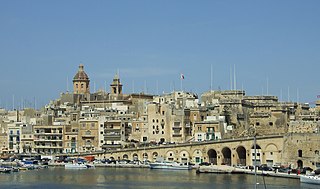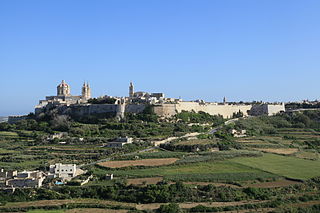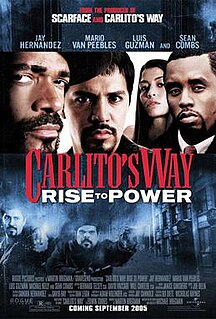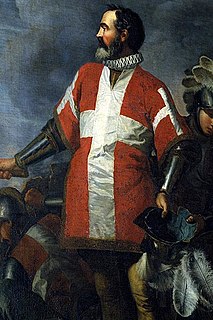
Nicolas Durand, sieur de Villegaignon, also Villegagnon was a Commander of the Knights of Malta, and later a French naval officer who attempted to help the Huguenots in France escape persecution.

Birgu, also known by its title Città Vittoriosa, is an old fortified city on the south side of the Grand Harbour in the South Eastern Region of Malta. The city occupies a promontory of land with Fort Saint Angelo at its head and the city of Cospicua at its base. Birgu is ideally situated for safe anchorage, and over time it has developed a very long history with maritime, mercantile and military activities.

Mdina, also known by its Italian-language titles Città Vecchia and Città Notabile, is a fortified city in the Northern Region of Malta which served as the island's capital from antiquity to the medieval period. The city is still confined within its walls, and has a population of just under 300, but it is contiguous with the town of Rabat, which takes its name from the Arabic word for suburb, and has a population of over 11,000.

The Great Siege of Malta occurred in 1565 when the Ottoman Empire attempted to conquer the island of Malta, then held by the Knights Hospitaller. The siege lasted nearly four months, from 18 May to 13 September 1565.

Fort Ricasoli is a bastioned fort in Kalkara, Malta, which was built by the Order of Saint John between 1670 and 1698. The fort occupies a promontory known as Gallows' Point and the north shore of Rinella Bay, commanding the entrance to the Grand Harbour along with Fort Saint Elmo. It is not only the largest fort in Malta but also the largest in Europe, and it has been on the tentative list of UNESCO World Heritage Sites since 1998, as part of the Knights' Fortifications around the Harbours of Malta.

Fort San Lucian, also known as Saint Lucian Tower or Fort Rohan, is a large bastioned watchtower and polygonal fort in Marsaxlokk, Malta. The original tower was built by the Order of Saint John between 1610 and 1611, being the second of six Wignacourt towers.

A redoubt is a fort or fort system usually consisting of an enclosed defensive emplacement outside a larger fort, usually relying on earthworks, although some are constructed of stone or brick. It is meant to protect soldiers outside the main defensive line and can be a permanent structure or a hastily constructed temporary fortification. The word means "a place of retreat". Redoubts were a component of the military strategies of most European empires during the colonial era, especially in the outer works of Vauban-style fortresses made popular during the 17th century, although the concept of redoubts has existed since medieval times. A redoubt differs from a redan in that the redan is open in the rear, whereas the redoubt was considered an enclosed work.

Fort Saint Elmo is a star fort in Valletta, Malta. It stands on the seaward shore of the Sciberras Peninsula that divides Marsamxett Harbour from Grand Harbour, and commands the entrances to both harbours along with Fort Tigné and Fort Ricasoli. It is best known for its role in the Great Siege of Malta of 1565.

Fort Saint Rocco, also known as Fort Saint Roca on some maps, is a polygonal fort in Kalkara, Malta. It is located east of Rinella Battery and seaward of the village of Santu Rokku, and forms part of the complex of shore batteries built by the British to defend the coast east of the mouth of Grand Harbour between the 1870s and 1900s.

Carlito's Way: Rise to Power is a 2005 prequel to Brian De Palma's 1993 film Carlito's Way. It is based on the 1975 novel Carlito's Way by Edwin Torres. The previous film was based on the 1979 Torres novel After Hours, but was retitled to avoid it being confused with Martin Scorsese’s 1985 film of the same name. The film was written and directed by Michael Bregman, who produced the first film. His father, Martin Bregman, produced both films. The film was released in limited theaters 20 days prior to being released on DVD.

The Waverley Novels are a long series of novels by Sir Walter Scott (1771–1832). For nearly a century, they were among the most popular and widely read novels in Europe.

The Battle of Djerba took place in May 1560 near the island of Djerba, Tunisia. The Ottomans under Piyale Pasha's command overwhelmed a large joint Christian Alliance fleet, composed chiefly of Spanish, Papal, Genoese, Maltese, and Neapolitan forces. The allies lost 27 galleys and some smaller vessels as well as the fortified island of Djerba. This victory marked perhaps the high point of Ottoman power in the Mediterranean Sea.

Christopher John Rocco, simply known as John Rocco is an American illustrator of book covers and children's books. He is best known for illustrating the covers of books in the Percy Jackson & the Olympians series. He is the sole creator of some children's picture books.

Dragut, known as "The Drawn Sword of Islam", was a Muslim Ottoman naval commander, governor, and noble, of Turkish or Greek descent. Under his command, the Ottoman Empire's maritime power was extended across North Africa. Recognized for his military genius, and as being among "the most dangerous" of corsairs, Dragut has been referred to as "the greatest pirate warrior of all time", "undoubtedly the most able of all the Turkish leaders", and "the uncrowned king of the Mediterranean". He was described by a French admiral as "A living chart of the Mediterranean, skillful enough on land to be compared to the finest generals of the time. No one was more worthy than he to bear the name of king".

The Siege of Malta is a historical novel by Walter Scott written from 1831 to 1832 and first published posthumously in 2008. It tells the story of events surrounding the Great Siege of Malta by the Ottoman Turks in 1565.

Hospitaller Malta, known within Maltese history as the Knights' Period, existed between 1530 and 1798 when the Mediterranean islands of Malta and Gozo were ruled by the Order of St. John of Jerusalem. The polity was formally a vassal state of the Kingdom of Sicily, and it came into being when Emperor Charles V granted the islands as well as the city of Tripoli in modern Libya to the Order, following the latter's loss of Rhodes in 1522. Hospitaller Tripoli was lost to the Ottoman Empire in 1551, but an Ottoman attempt to take Malta in 1565 failed.

Fra' Jean "Parisot" de la Valette was a French nobleman and 49th Grand Master of the Order of Malta, from 21 August 1557 to his death in 1568. As a Knight Hospitaller, joining the order in the Langue de Provence, he fought with distinction against the Turks at Rhodes. As Grand Master, Valette became the Order's hero and most illustrious leader, commanding the resistance against the Ottomans at the Great Siege of Malta in 1565, sometimes regarded as one of the greatest sieges of all time.

San Rocco Battery was an artillery battery in Kalkara, Malta, built by Maltese insurgents during the French blockade of 1798–1800. It was the last in a chain of batteries, redoubts and entrenchments encircling the French positions in Marsamxett and the Grand Harbour. It was built to control the entrance to the harbour as well as the French occupied Fort Ricasoli. The battery was continually being fired upon from the French at Ricasoli.

San Rocco Redoubt was a redoubt in Kalkara, Malta. It was built by Great Britain during the French blockade of 1798-1800. It was part of a chain of batteries, redoubts and entrenchments encircling the French positions in Marsamxett and the Grand Harbour.

The Information Officer is the third novel by English author Mark Mills, published in 2009 by HarperCollins.




















